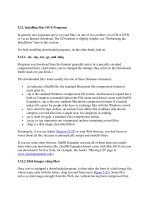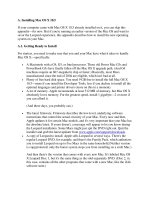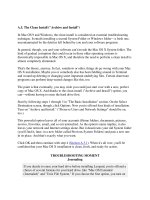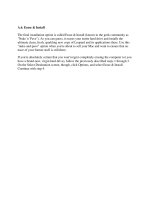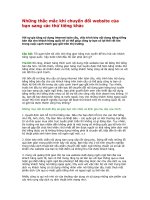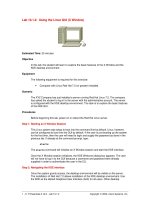Tài liệu A. Installing Mac OS X pdf
Bạn đang xem bản rút gọn của tài liệu. Xem và tải ngay bản đầy đủ của tài liệu tại đây (33.81 KB, 1 trang )
A. Installing Mac OS X 10.5
If your computer came with Mac OS X 10.5 already installed on it, you can skip this
appendix—for now. But if you're running an earlier version of the Mac OS and want to
savor the Leopard experience, this appendix describes how to install the new operating
system on your Mac.
A.1. Getting Ready to Install
For starters, you need to make sure that you and your Mac have what it takes to handle
Mac OS X—specifically:
•
A Macintosh with a G4, G5, or Intel processor. Those old Power Mac G3s and
PowerBook G3s have finally fallen off the Mac OS X upgrade path. (And G4
machines require an 867-megahertz chip or faster.) Basically, most Macs
manufactured since the end of 2004 are eligible, which isn't bad at all.
•
Plenty of free hard disk space. You need 9 GB free to install the full Mac OS X
10.5—more if you install the Developer Tools, less if you decline to install all the
optional languages and printer drivers (more on this in a moment).
•
A lot of memory. Apple recommends at least 512 MB of memory, but Mac OS X
absolutely loves memory. For the greatest speed, install 1 gigabyte—2 or more if
you can afford it.
(And these days, you probably can.)
•
The latest firmware. Firmware describes the low-level, underlying software
instructions that control the actual circuitry of your Mac. Every now and then,
Apple updates it for certain Mac models, and it's very important that your Mac has
the absolute latest. If yours doesn't, a message will appear to let you know during
the Leopard installation. Some Macs might just spit the DVD right out. Quit the
installer and grab the latest updater from www.apple.com/support/downloads
.
•
A copy of Leopard to install. Apple sells Leopard in several ways. There's the
regular Leopard DVD, for example, and there's the Family Pack, which authorizes
you to install Leopard on up to five Macs in the same household.(Neither version
is copyprotected; only the honor system stops you from installing on a sixth Mac.)
And then there's the version that comes with every new Mac. It's labeled Mac OS
X Leopard Disc 1, but it's the same thing as the sold-separately DVD. (Disc 2, in
this case, contains all the other programs that come with a new Mac, like the iLife
software suite.)
